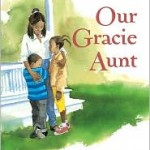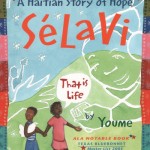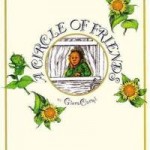Although I can’t recall reading any picture books that explored serious social issues when I was a child, I was certainly surrounded by them in every day life. Because I grew up on the U.S.-Mexico border, many of my classmates were the children of immigrants, both documented and undocumented. My classmates all received free breakfasts and lunches becausetheir families were so poor. Two of my friends at one point lived in a chicken coop, literally, and their mother—an undocumented immigrant who had fled an abusive husband in Mexico—supported six children on her maid’s salary of less than $25 a day. Another friend lived with her parents on the grounds of an immigration detention center, and I remember visiting her mother at work, who had to unlock a set of three doors before we could enter the building where they had locked up refugees fleeing the violence of U.S.-supported wars in El Salvador, Nicaragua, and Guatemala.
I grew up seeing extreme poverty—and the damage that does to families and children—as well as the resilience of the human spirit; I grew up observing U.S. laws that sent refugees back to their war-torn countries to die, and watching as hard-working folks broke those U.S. laws for the good of their families. I never saw my world represented in children’s literature—not in picture books or, as I got older, in middle-grade or young adult fiction. In fact, I spent most of my childhood believing that the place I lived and the people who were my friends and family were inferior because our lives were nothing like the lives of people I read about in books. Although many more writers are exploring social issues in children’s literature, and “diversity” and “multicultural” have become buzz words in the industry, there is still a dearth of serious, artistic picture books that delve into the darker and more complicated sides of human experience. Out of a desire to protect some children from the realities of racism, poverty, and violence, we’ve neglected a very broad and deep swath of children whose experiences and lives are rarely portrayed in picture books.
In this blog post, I’m going to focus on how the concept of homelessness has been explored in picture books in order to show four methods writers can use to explore dark and serious issues for a very young audience.
The Caring Adult
 The most common path writers walk when placing protagonists in dark situations in picture books is providing a caring adult who accompanies them through the darkness. Every single picture book on homelessness that I encountered, with one exception, used this solution to mitigate or make palatable the darkness of the problem.
The most common path writers walk when placing protagonists in dark situations in picture books is providing a caring adult who accompanies them through the darkness. Every single picture book on homelessness that I encountered, with one exception, used this solution to mitigate or make palatable the darkness of the problem.
For example, Fly Away Home by Eve Bunting depicts a young boy who lives in an airport with his father. His father has a part-time job but it’s not enough to rent their own apartment. When the boy’s father works, he is taken care of by another homeless adult who also lives in the airport. Likewise, A Shelter in Our Car by Monica Gunning depicts a single parent—in this case, a mother—who struggles financially because all she can get is day-work. She and her daughter live in their car because it is quieter and more private than a shelter.
The Caring Adult Solution is a natural one, but it has its limitations. There are many children out there who never find a caring adult to usher them through the abuse, violence, or neglect they encounter. I found only one book that depicts children struggling to find solutions to homelessness without adult intervention. In Selavi: A Haitian Story of Hope by Youme Landowne, Selavi loses his parents and ends up homeless, living on the streets of Port-au-Prince, Haiti with other street children. The fact that many of the adults in this story serve to further impoverish the children, rather than help them, is one of the things that has caused some librarians to dismiss the book and to tell Youme that they can’t read it to children. Ultimately, Youme felt it was more important that the truth of this harsh story be told than to change it so that it wouldn’t encounter censorship. “The children in Haiti had these experiences and lived through them,” Youme told me in an interview. “They knew about wealthy children hearing from their parents that ‘street children’ weren’t good children because they were poor, and the children didn’t want other children being taught that.”
Presenting Only Part of the Story
Many of the books present only part of the story rather than offering young readers a glimpse of the complicated situation that the protagonists find themselves in. This is true for a number of reasons—space constraints within the picture book genre, getting the book through various censors, and, of course, the all-consuming concern we have to preserve children’s innocence.
 Jackie Woodson’s Our Gracie Aunt—where two children are displaced from their home through neglect—never mentions the mother’s drug or alcohol abuse. We just understand that “Mama’s going somewhere and can’t take care of her kids right now.” Likewise, An Angel for Solomon Singer by Cynthia Rylant shows an adult protagonist struggling to make it on the streets of New York City. The narrator never mentions that Solomon Singer is on the brink of homelessness, never explains how he came to be living in a Bowery hostel, or how he manages to pay for his limited shelter and food. The strategy is a good one to use but I do wonder what questions children will have. When reading An Angel for Solomon Singer, what will a child make of this adult who seems perfectly capable but who spends his life wandering through city streets, imagining a better place? When reading Our Gracie Aunt, what story will children create in their minds to explain Mama’s absence? Since picture books are usually read with an adult present, perhaps that adult can provide answers to the questions that naturally rise.
Jackie Woodson’s Our Gracie Aunt—where two children are displaced from their home through neglect—never mentions the mother’s drug or alcohol abuse. We just understand that “Mama’s going somewhere and can’t take care of her kids right now.” Likewise, An Angel for Solomon Singer by Cynthia Rylant shows an adult protagonist struggling to make it on the streets of New York City. The narrator never mentions that Solomon Singer is on the brink of homelessness, never explains how he came to be living in a Bowery hostel, or how he manages to pay for his limited shelter and food. The strategy is a good one to use but I do wonder what questions children will have. When reading An Angel for Solomon Singer, what will a child make of this adult who seems perfectly capable but who spends his life wandering through city streets, imagining a better place? When reading Our Gracie Aunt, what story will children create in their minds to explain Mama’s absence? Since picture books are usually read with an adult present, perhaps that adult can provide answers to the questions that naturally rise.
The truth is, every time we write a story, no matter the audience, we choose to leave certain parts out. To write Selavi, Youme Landowne went to Haiti and spent time at the shelter that the Haitian street children had created. After the book came out, she says a researcher “published a short paper saying that Selavi glorifies what was a terrible situation. There were a lot of terrible things going on at that shelter,” she says, “and at the same time, a lot of incredible things were happening. So as storytellers, we’re making choices about what parts of the story we’re going to tell.”
Open-Ended Conclusions
All but three of the books I found offered a solution to the problem of the protagonist’s homelessness by the end of the picture book. Given the intricacies of homelessness, this is not the most realistic ending, so I was happy to see that three of the picture books on homelessness chose another strategy—open-ended conclusions, which suggest that the story is on-going, that the problem is not easily resolved.
In Fly Away Home, the protagonist feels hopeless about his chances of ever being able to have a home of his own until he remembers the day he watched a bird, stuck in the airport, trying to get out. The bird kept flying against the glass until it hurt itself. Finally, it managed to get out when the sliding glass doors opened. So although the boy’s problem is not solved at the end of the story, he does realize that, like that bird, he and his father will have their chance someday and they need to be ready to take it when it comes.
Homeless by Bernard Wolf uses photographs to depict a real child in New York whose family became homeless and sought help from the Henry Street Settlement Urban Family Center in Manhattan. Because it’s non-fiction, the book ends without offering a simple solution—it can’t, because the actual family didn’t have a solution. Yet it still ends in a hopeful place—the family is celebrating Christmas with presents for the first time in several years.
 In Selavi, the protagonist encounters other street children who form a community. Together, they build a homeless shelter. When adult members of the community burn their shelter to the ground, the street children re-build it and also start a community radio program, by and for children. Youme leaves her books open-ended for two reasons: one, because her books are non-fiction, and two, because real life is like that. “In all of my books,” she told me, “I don’t end saying that it’s all okay. I say that the strength of the people in that situation made it better than it was before.”
In Selavi, the protagonist encounters other street children who form a community. Together, they build a homeless shelter. When adult members of the community burn their shelter to the ground, the street children re-build it and also start a community radio program, by and for children. Youme leaves her books open-ended for two reasons: one, because her books are non-fiction, and two, because real life is like that. “In all of my books,” she told me, “I don’t end saying that it’s all okay. I say that the strength of the people in that situation made it better than it was before.”
Although these three books recognize the fundamental ambiguities of homelessness, they still concluded with a hopeful image, something that most writers see as a fundamental necessity in picture books, given the age of the audience.
Encouraging Good Deeds
Several of the books encourage children towards selfless acts or good deeds, not in a didactic way but simply as part of the story. This is one way of introducing concepts of poverty to children who have never directly experienced it. It may prompt children who do experience poverty to nevertheless cultivate a generosity of spirit, as we see in December by Eve Bunting. In this story, young Simon and his mother live in a little cardboard house. On Christmas Eve, an old woman knocks on their cardboard door and asks if she can sleep with them that night because she is so cold. Simon’s mother says yes. And Simon, seeing that she’s hungry, gives her one of the Christmas cookies that he bought with all the cans he’d collected. It’s not an easy gesture for him since it means there is only one cookie left, and he and his mother will have to split it tomorrow. That night he dreams there’s an angel with them in their cardboard shack. When he wakes up, the old woman is gone, but their luck has changed. By the next Christmas, he and his mother have an apartment in the projects, and a real tree, and cookies again. And when Simon looks closely at the angel that decorates their tree, he sees it looks like that old woman. Here, we see that Simon’s act of selflessness—giving up the cookie he has worked so hard to get—earns him an even greater reward, that is, divine intervention, miraculous help for solving the problem of their poverty and homelessness.
 A Circle of Friends by Giora Carmi is a wordless picture book that shows a young boy leaving a muffin for a homeless man, who gives crumbs to the birds. One of the birds takes a sunflower seed and drops it in the planter outside the boy’s room, and it sprouts. Though the book includes a homeless man, that is almost a coincidence within the story. It is really a story about karma, generosity, and how doing good will result in a reward.
A Circle of Friends by Giora Carmi is a wordless picture book that shows a young boy leaving a muffin for a homeless man, who gives crumbs to the birds. One of the birds takes a sunflower seed and drops it in the planter outside the boy’s room, and it sprouts. Though the book includes a homeless man, that is almost a coincidence within the story. It is really a story about karma, generosity, and how doing good will result in a reward.
You and Me and Home Sweet Home by George Ella Lyon tells the story of a young girl and her mother who live with relatives because they can’t afford to live on their own. Their entire church comes together and builds them a house, using donated time and materials. The story is a faith-building one in the power of community. The characters are able to see tangible results for their good deeds—a house for a mother-daughter duo.
Conclusion
None of the strategies I’ve presented here are perfect solutions to writing about complicated and dark issues for children, nor are they an exhaustive list. I should add that there are two strategies commonly used by picture book writers to deal with dark and serious issues that I deliberately didn’t explore today. The most common one—so common, it is now a cliché—is to use animal protagonists rather than children. Another strategy is to set a book in a historical time period, a particularly common approach when dealing with race or poverty. I love animals and I’m a historian so I love history. Of course we should have books with animal protagonists and of course we should have books about the Holocaust and slavery. Yet I would argue that these two tactics serve to distance readers from the reality they are trying to portray rather than to recognize it in a way that validates and expands children’s experiences of the complex world in which we live. If the only books children encounter on race deal with slavery or the civil rights movement, or are presented with non-human protagonists, then it’s easy for these same kids to assume that racism no longer plagues us today—and I’ve met plenty of kids who think that, by the way.
I believe the state of the publishing industry reflects a poverty of mind in American society. With some rare exceptions, we aren’t interested in exploring the variety of human experience. Instead, we normalize the experience of children growing up in middle-class and upper-class homes who are sheltered from the darkness that pervades the world. There is no easy solution to this problem. Of course, there is nothing wrong with writing about middle-class and upper-class American homes. But I hope that more writers will consider taking on the responsibility of writing about dark issues in picture books, thus giving kids the tools they need to deal with the complexity of the world we live in. If there are more voices speaking out, they will be harder to ignore.
8 comments for “Homelessness in Picture Books”